https://www.musical-u.com/learn/music-business-whats-changed-whats-stayed-cliff-goldmacher/
How do you know that “expert” advice on your songwriting and songwriting career is really going to help? You need to meet someone like Cliff Goldmacher! https://www.musical-u.com/learn/music-business-whats-changed-whats-stayed-cliff-goldmacher/
There are three elements of music: melody, harmony and rh…
https://www.musical-u.com/learn/hone-sense-rhythm/
There are three elements of music: melody, harmony and rhythm. Learning rhythm is sometimes neglected, yet it is the gas of the music engine: https://www.musical-u.com/learn/hone-sense-rhythm/
As a musician 🎵, you’ve probably heard of or experienced…
https://www.musical-u.com/learn/overcome-stage-fright/
As a musician 🎵, you’ve probably heard of or experienced stage fright. 😰 Here are 5 different ways you can practise to better manage and control your adrenaline and ultimately, enhance your stage presence. 👍 https://www.musical-u.com/learn/overcome-stage-fright/
All music consists of three main elements (in varying pro…
https://www.musical-u.com/learn/developing-your-rhythmic-ears/
All music consists of three main elements (in varying proportions): Melody, Harmony and Rhythm. As we build our understandings of these basic structures, extracting musical ideas from our creative mind becomes a directed process rather than random guesswork. https://www.musical-u.com/learn/developing-your-rhythmic-ears/
A lot of discussion can be had over whether the guitar 🎸…
https://www.musical-u.com/learn/how-to-tune-your-guitar-by-ear/
A lot of discussion can be had over whether the guitar 🎸 should be tuned by ear or with the help of an electronic device. In times of desperate need, when all your digital tuners have died slow deaths, all you have to rely on are your hands and your ears! 👂 https://www.musical-u.com/learn/how-to-tune-your-guitar-by-ear/
When we listen to a song, our first instinct is to listen…
https://www.musical-u.com/learn/hearing-harmonies-active-listening/
When we listen to a song, our first instinct is to listen first to the melody and the lyrics. Have you ever tried focusing on the harmony of a song, instead? 🙂🎵 https://www.musical-u.com/learn/hearing-harmonies-active-listening/
Musicality Podcast Giveaway, Tune Your Guitar, G4 Guitar Method, and a Misty Cover
At the turn 20th century, a quiet, humble six-stringed instrument was fitted with steel strings – growing louder, more versatile, and more popular. A few decades later – amplified with electronic pickups – the guitar continued its rapid evolution into the monster musical machine it is today.
This week Musical U pays homage to this musical wonder of the world with a simple guitar/voice cover of a high-production Father John Misty song, a revolutionary guitar learning method, and a complete guide to how – and why – to tune your guitar by ear.
So you’re not a guitar player (even though you wish you were!)? Let’s begin with something for everyone who wants to become more free and natural in their musical expression – a new giveaway.
That’s right,
Musical U is giving away free stuff
… to help you grow in your musicality. Why?
In his quest to help more musicians acquire the freedom and naturalness of expression they desire, Musical U founder Christopher Sutton has been reaching out to the greatest minds in modern musicality education. Into their methods, and also into their backstories to learn more about their own musical journeys.
 In addition, Christopher has been inspired to produce his own series of teaching podcasts on the musicality questions you care about most.
In addition, Christopher has been inspired to produce his own series of teaching podcasts on the musicality questions you care about most.
The results are in and we have a fantastic lineup of podcasts scheduled to launch next week.
If you’ve been hanging around Musical U at all the past month, you can tell that we’ve been pretty pumped about this new Musicality Podcast series. You may even have grabbed a free subscription to the Podcast Insiders to stay on top of all the podcast news and promotions.
So, in celebration of the launch, we’re giving away an amazing array of memberships, apps, software, worksheets – from Musical U and many other musicality educators.
So head over to The Musicality Podcast Launch: Prize Giveaway! to find out how you can fill your musical toolbox in one fell swoop – for free!
From a Big Band to a Single Guitar
 In our Before and After posts, we’ve been learning so much by examining the process of transforming an original tune into a cover. This week, we witnessed the power of a
In our Before and After posts, we’ve been learning so much by examining the process of transforming an original tune into a cover. This week, we witnessed the power of a
single guitar.
Kendra McKinley breaks down all Father John Misty’s entire band into a jazzy arrangement on her gold top and soars over the whole thing with passionate, heartfelt vocals. See how she does it with a look at Before and After: Covering Father John Misty.
“When You’re Smiling and Astride Me” doesn’t follow the standard pop music arrangement, but it works precisely due to the way that the song builds. Learn more about creating interesting arrangements from Sound Shock.
Father John Misty frequently starts songwriting with just his guitar and voice, which leads to the chords and melody being the main driving factor behind the song. This strategy of starting very simply is how many of the greatest songs that you may know of had their beginnings. Start your songwriting journey (on any instrument!), with Guitar Adventures.
To create this cover song, Kendra had to change the key to fit within her vocal range. This is a very common practice for many musicians. Key changes can also have the additional impact of changing the color of a song! To do this, you need to become comfortable with the art of transposition. From the Top lays out four easy steps to master transposition.
A common practice for guitar players is to use a capo to quickly change the key of a song. This has the added benefit of not needing to change chord voicings “on the fly” and keep open strings available to your harmonies. To get started using a capo, with Eric Blackmon Music:
Tune Up
With all the gizmos and gadgets available, what’s the point of tuning your guitar by ear?
Musicality means that you are connected with your instrument, that you really hear what you’re doing. Sure, you can learn to press the “right” buttons in the “right” order, but are you really making music?
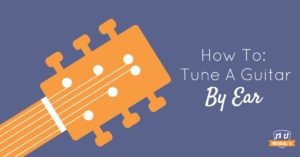 Connecting with your instrument is a deeply satisfying step to bringing out and expressing the music that is within you. And tuning your guitar by ear – apart from being a very learnable and fun skill – can actually become a foundational step to your ear training.
Connecting with your instrument is a deeply satisfying step to bringing out and expressing the music that is within you. And tuning your guitar by ear – apart from being a very learnable and fun skill – can actually become a foundational step to your ear training.
Learn more about the art of tuning – including all those cool alternate tunings – as you learn How To Tune A Guitar By Ear.
Sometimes it seems as though every guitar player has their unique way to tune their instrument. It can almost become a habit, your own private ritual before beginning the practice session. Another secret trick is to use harmonics when tuning – with these high pitches, it can be easier to hear the waves that are present when strings are not in tune. Justin Guitar has this great lesson to get you started tuning your guitar with harmonics.
How are interval ear training and tuning a guitar related? And can interval ear training supercharge your ability to quickly tune your guitar? Absolutely! David Dimuzio has some super tips on tuning using intervals:
You did it! Your guitar is perfectly in tune (by ear) and you’re ready to start playing. Only to come back the next day and it sounds just as bad as before your careful tuning. Why don’t guitar strings simply stay in tune after all your meticulous work? And what about those other tuning problems? Roadie Tuner knows all about why guitars go out of tune – and what to do about it.
We talk a lot about learning to play by ear, tune by ear, and developing your musical ear. How will this change as you get older and (inevitable) need some sort of hearing aid? Does this mean that your days of enjoying music are over? Not at all! Hearing Aids For Music details one musician’s journey through hearing loss, and how he overcame it!
B4 G4 – and after
With all massive throngs picking up the guitar, you may be surprised to learn that the most popular method book was published over 40 years ago, and was never tested on real students!
What’s more, most method books ever since have blindly followed the same model. And the centuries-old one-to-one private lesson model still pervades.
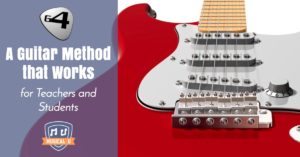 David Hart loved teaching guitar. But he was frustrated with both the inefficiency of the old model for the student’s learning, as well was the near-impossibility of making a decent living as a guitar teacher. He tried starting his own music school, but it was still not enough.
David Hart loved teaching guitar. But he was frustrated with both the inefficiency of the old model for the student’s learning, as well was the near-impossibility of making a decent living as a guitar teacher. He tried starting his own music school, but it was still not enough.
Enter the G4 guitar method.
David methodically tried and tested more efficient ways to learn what matters most to guitar students and came up a system that his students and his teachers absolutely love. We spoke with him at length about this Guitar Method that Works – for Teachers and Students.
David started the conversation by talking about the 80/20 principle, and how that applies to music. Wait a minute… what is the 80/20 principle? While we cannot do it justice here, Mark Samples talks all about how this fascinating 80/20 principle can be applied to fight against perfectionism with productivity deep-hacks for musicians.
Learning music has benefits that far exceed just the act of playing your instrument. The connections between neuroscience and music education have been long established and continue to be a way to strengthen your brain. For more information about the benefits of music education and how to memorize music faster, this fascinating podcast from Becoming Superhuman is a great listen!
Many want to learn music or improve their learning, but don’t know how to get past their obstacles. Having a system in place, that guides you through the process of learning a new skill, is highly valuable and will keep you on the right path. Here is a wonderful guide on how to learn the art of music production as fast as possible. These principles can be applied to almost anything that you are trying to accomplish!
The internet has changed how we learn and interact with the world. The amount of information available is seemingly unlimited, and this increases our ability to learn more about topics we are passionate about. In addition to the resources at Musical U, there are many other great educators that can be found in the online space. For a list of online games that can help you in your quest to become a better musician, check out TpT Music Crew.
Guitar and Beyond
With all the info out there, and our exposure to so much astounding musical creativity, musicians of the 21st century are finding out that there are better ways to learn.
So enjoy a guitar method that works, sharpening your tuning ear, and creating beautiful guitar covers. And get ready to launch into musical freedom with the Musicality Podcast Giveaway.
The post Musicality Podcast Giveaway, Tune Your Guitar, G4 Guitar Method, and a Misty Cover appeared first on Musical U.
How To Tune Your Guitar By Ear
A lot of discussion can be had over whether the guitar should be tuned by ear or with the help of an electronic device. As we’re about to see, tuning by ear has multiple benefits over the “easier” path of using a tuner.
Guitars go out of tune for all sorts of different reasons, and you won’t always have an electronic tuner around to help you out. For quick, on-the-fly tuning, tuning by ear reigns supreme.
By the end of this guide on how to tune a guitar for beginners, you’ll know how to tune your guitar with just your hands and ears, popular alternate tunings, and how to check that you’ve tuned correctly by using a piano.
Why You Should Tune Your Guitar By Ear (Instead of Relying on an Electronic Tuner)
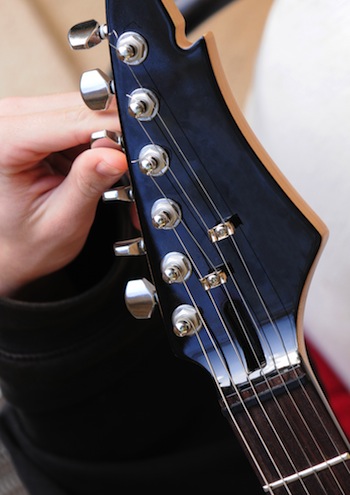 Learning how to tune a guitar with a tuner is easy. You’ve probably got one of the thousand-and-one guitar tuner phone apps or software that can pick up your guitar sound, analyse the frequencies and tell you how you should turn your tuning pegs. You can find electronic tuner boxes all around any guitar shop. Maybe there’s even one built into your acoustic guitar.
Learning how to tune a guitar with a tuner is easy. You’ve probably got one of the thousand-and-one guitar tuner phone apps or software that can pick up your guitar sound, analyse the frequencies and tell you how you should turn your tuning pegs. You can find electronic tuner boxes all around any guitar shop. Maybe there’s even one built into your acoustic guitar.
So why am I encouraging you to practice tuning by ear?
It’s because it lays the foundation of pitch ear training. If you can understand the pitch relationships between notes and become sensitive to details of tuning just by consistently tuning your guitar every day, you’ll have built a solid foundation of pitch skills.
After a month’s practice, you’ll be able to strum once and instantly tell whether the guitar is in tune or not, and a little after that you will even be able to tell straight-off which string sounds different than it should. So tuning by ear lays the basic foundation for understanding notes just by listening. Some guitarists even use it as the basis for developing perfect pitch.
Step By Step Instructions For Tuning A Guitar By Ear
Here is our guide to how to standard tune your guitar by ear. But before we dive into the nitty-gritty of tuning, it’s important to understand the basics of your guitar.
Prepare: Check Your Pegs
If you haven’t tuned your guitar before, take a moment to familiarise yourself with your tuning pegs. Depending on whether your pegs are all on one side (electric style) or three on each side (acoustic style) and whether the guitar has been strung in the normal way, the directionality of each peg might vary.
You want to find out: does turning the peg clockwise make the string tighter (and its pitch higher) or looser (and its pitch lower)?
Once you get familiar with this setup on your guitar it will become instinctive and you won’t need to think about it again.
Prepare: Understand How Guitar Strings Work
 When you’re looking down at the six strings of your guitar, you’ll notice that the strings go from thickest to thinnest. The topmost thickest one is your low E string, also called the sixth string. Following that, the next thickest is A, or the fifth string, and so on, all the way to your first string (the high E). The pitch order of strings in standard tuning, from sixth string to first string, and therefore from lowest to highest, is EADGBE. We always tune in “reverse” order, starting with the sixth string, or low E, and continuing in order all the way to the first string, or high E.
When you’re looking down at the six strings of your guitar, you’ll notice that the strings go from thickest to thinnest. The topmost thickest one is your low E string, also called the sixth string. Following that, the next thickest is A, or the fifth string, and so on, all the way to your first string (the high E). The pitch order of strings in standard tuning, from sixth string to first string, and therefore from lowest to highest, is EADGBE. We always tune in “reverse” order, starting with the sixth string, or low E, and continuing in order all the way to the first string, or high E.
You can help yourself remember this pitch sequence with a mnemonic, such as “Every Apple Does Go Bad Eventually”. For for something more ominous, you can use “Eddie Ate Dynamite Good Bye Eddie”.
Now that you know how pegs and strings work, you are ready to begin. Lowest string first…
Sixth String: Low E
Listen to any example of a “correct” E note as your reference pitch. For example you can use a recording of a standard E note like the one below and play it in your speakers, or use a pitch pipe. Listen, and play the E string of your guitar.
If you use a guitar sound, pitch pipe or other simple “tone” it is comparatively easy to tune by ear. If you have to use another instrument such as a nearby piano, you might find the difference in timbre makes it harder to compare the notes’ pitches.
Now, after playing the reference E note, let the sixth string of your guitar ring, and if you find the two sound perfectly the same, then your sixth string is in tune. More likely you will hear a slight clash (discord) which means your guitar string is slightly out of tune.
As you practice tuning and do pitch ear training you’ll find you can directly hear whether your guitar string is too high or too low. At first it might take a bit of experimentation.
Slowly rotate the tuning peg of your sixth string, gradually adjusting in one direction to see if the two notes come into agreement. If they don’t, and you hear that the pitches are becoming further apart, simply reverse your direction and adjust pitch until the two notes match.
Note: The tension of the string shouldn’t become too high (i.e. tight) or too low (i.e. loose). This means you are trying to tune the string into either a higher octave, where the note would match but the string would become so tight it might snap, or a lower octave, where the string would become unplayably loose.
Fifth string: A
Once the E string is in tune, you can put your reference note aside – from here you can tune the other strings based on your (now nicely-tuned) sixth string.
On the E string, playing the 5th fret should produce the same note as the open A string. So, place your finger on the 5th fret and play both the E string and the A string one by one. If the A string sounds higher, rotate its tuning peg to lower its pitch. If it sounds lower, rotate it the other way. Until and unless you feel that the notes sound exactly the same when played in unison, you should adjust the tuning peg accordingly.
Fourth string: D
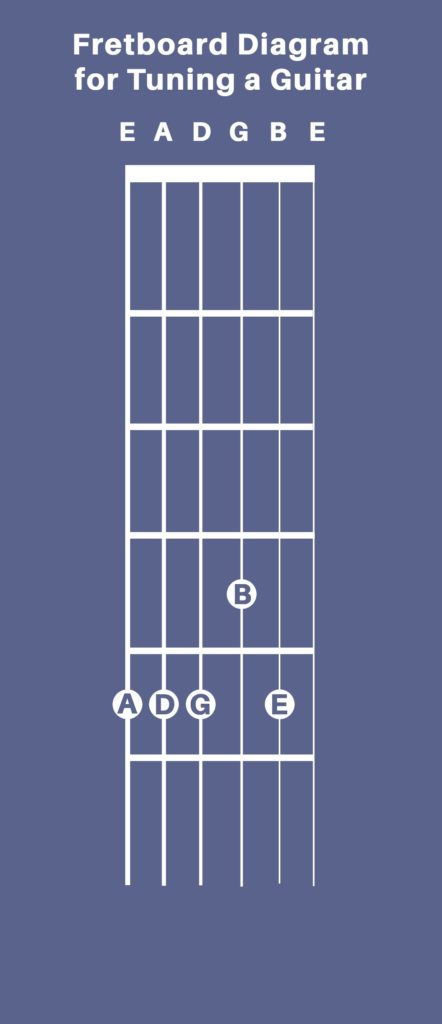 The note on the 5th fret of the A string you just tuned will be same as the open note of the D string you’ll tune next. Play the two strings in unison, by placing your finger of 5th fret of the fifth string and ringing the open note of the fourth string. Listen for whether the two notes are the same, in close discord, or have a noticeable gap in pitch. Adjust your tuning peg until you hear they are perfectly tuned.
The note on the 5th fret of the A string you just tuned will be same as the open note of the D string you’ll tune next. Play the two strings in unison, by placing your finger of 5th fret of the fifth string and ringing the open note of the fourth string. Listen for whether the two notes are the same, in close discord, or have a noticeable gap in pitch. Adjust your tuning peg until you hear they are perfectly tuned.
Third string: G
Timbre problems may arise when you try to tune your third string (which represents the G note) to the fourth string. This is because on both acoustic and electric guitars there is typically a change in string type: either from nylon to steel or from single strings to wound strings. This affects the timbre of the note and can make it harder to directly compare pitches. Don’t worry, you’ll get the hang of this soon enough!
Now you should be getting the hang of the process as you tune your third string, which should be a G note. On the 5th fret of your fourth string is a G, so you can use this to tune your third string’s open note. Once again, listen to it and check if they sound similar. If not, turn the tuning peg for higher or lower pitch until they match.
Second string: B
Nearly finished!
Place your finger on the 4th fret of the third string, which will produce a B, the same as the open note of your second string. Or at least, it will be once you tune up that second string! Adjust your B string, until the two notes sound alike.
Pro Tip: It’s the 4th fret we use this time, not the 5th!
First string: High E
Finally the last one, your high E string. You can tune this in two ways:
- Since your low E string is already tuned, you can tune your high E by referring to this one. However, note that they are actually two octaves apart, so you may find this gap makes it difficult to compare the two pitches.
- If you are new to tuning you might want to avoid that, and instead continue with the method we have been using: place your finger on the 5th fret of the second (B) string, and you will play an E which exactly matches your open first string. Again, rotate counter-clockwise for higher pitch and clockwise for lower pitch.
You’re Done!
Finish up the tuning process by checking each of those note pairs in turn, from your low E and A string on up. Check the low E against your source note again. If any don’t sound quite correct, adjust the peg to make them match, but make sure you follow the low-to-high sequence again. This means that if the pair of notes don’t match, adjust the tuning of the higher string to match the lower one. This way your tuning is always rooted on your low E string. If you have access to a reference note for the high E string you can also check that one directly.
Finally, strum a few chords and play a riff or two. Does anything sound strange or wrong with the tuning? If so, listen carefully and try to identify which string is to blame. Then return to your note pair comparisons to make the required fix.
Pro Tip: The above method also works for the 12-string guitar, with some tweaks. Also, because its four strings follow the same tuning as the lowest four strings of the guitar (EADG), this method can be used to tune the bass.
How Do I Know If I’ve Tuned Correctly?
When you’re just starting to tune your guitar by ear, you’ll want to check that you’ve done it right. This can be achieved in several ways. You’ll feel tempted to simply tune with these methods to begin with, but we encourage you to resist the temptation! Use these methods to double-check that your tuning by ear was done correctly.
Check with a Tuner
Broadly speaking, there are three types of tuners out there that you can use, with each suited to different scenarios.
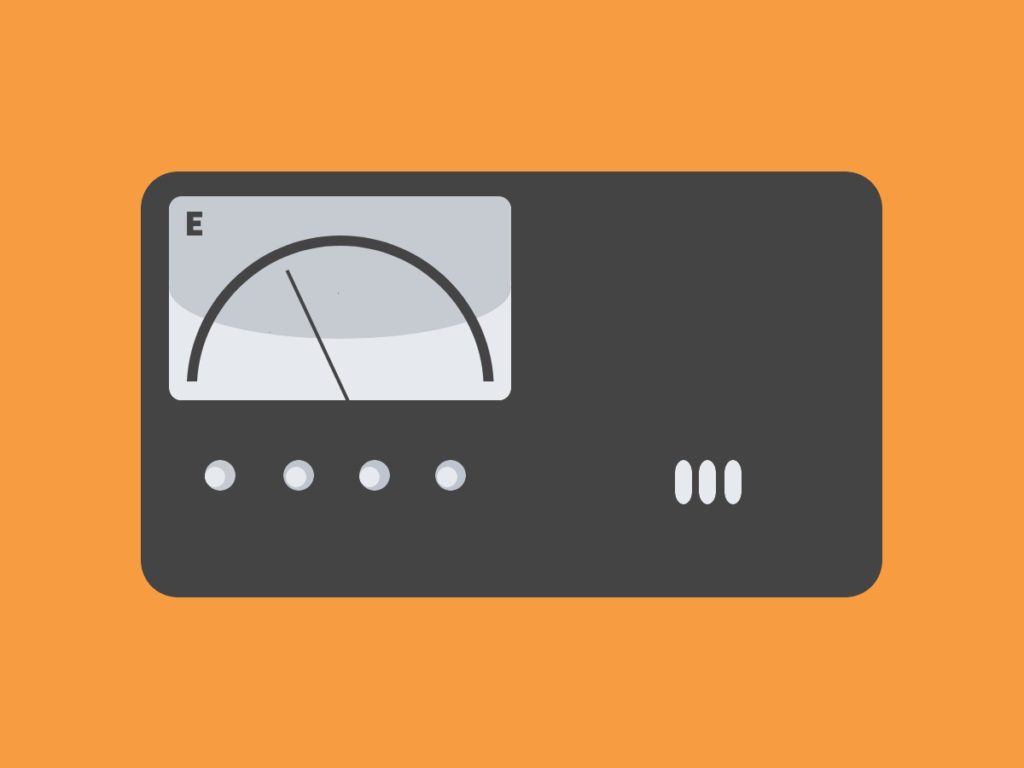 A standard tuner is a rectangular, “box-shape” tuner that tells you if and by how much your note is off-pitch from standard tuning. It can be used with both electric and acoustic guitars; the built-in microphone picks up on the pitch you are playing, or you can use the tuner’s input jack for a more precise reading for electric or electroacoustic guitars.
A standard tuner is a rectangular, “box-shape” tuner that tells you if and by how much your note is off-pitch from standard tuning. It can be used with both electric and acoustic guitars; the built-in microphone picks up on the pitch you are playing, or you can use the tuner’s input jack for a more precise reading for electric or electroacoustic guitars.
A pedal tuner is simply a guitar pedal that simply checks the pitch of your strings instead of laying fuzz or distortion over your sound. They are incredibly precise, but unfortunately only work with electric or electroacoustic guitars.
A headstock tuner will clip onto your guitar, sensing the pitch of a string through the vibrations created when you pluck a string, and telling you whether your note is flattened, sharpened, or just right. If you’re wondering how to most accurately tune a classical guitar, this is it.
Also, if you were wondering whether you can tune a ukulele with a guitar tuner, the answer is absolutely yes: many headstock tuners have a “ukulele” setting.
Pick one that works with your guitar, and see how accurate your tuning by ear is!
Check with a Piano
As well as being an easy and reliable way to check your tuning, this is a good ear training exercise for recognizing the same pitch on two different instruments. Simply compare the pitch of each string to the pitch of the corresponding key on the piano.
The best part is, you don’t even have to worry about an octave difference. Here’s a cheat sheet for which keys correspond to each pitch for guitar standard tuning; the numbers designate the note’s position from the left on a standard piano keyboard. For example, D3 is the third-lowest D key on the piano. Middle C is shown in orange:
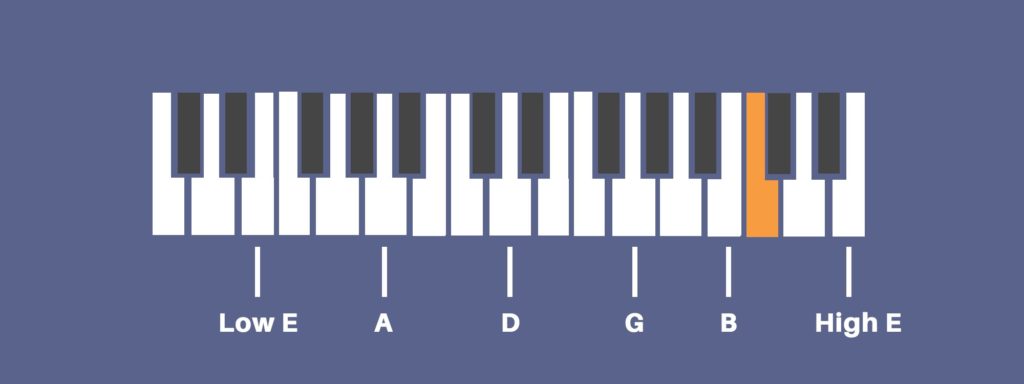
Alternate Tunings
The tuning EADGBE is known as standard tuning, and is the most popular.
However, it is far from being your only option. You can alter the tuning of a string or two to open up a whole new way of playing, with chords that would be impossible in standard tuning! The best part: you can do this with just your hands and ears, no tuner necessary. Electronic tuners often don’t have settings for these alternate tunings, so it’s incredibly useful to be able to do this by ear!
If you want to push limits of your guitar playing and songwriting, try one of the following alternate tunings. With each one, you’ll want to start in standard EADGBE tuning, and tweak accordingly.
How to Tune a Guitar a Half-Step Down
You may see some guitar tabs asking that you tune each string a half-step down. Fear not – this isn’t nearly as much of a pain as you may think.
- Fret the fifth (A) string at the sixth fret. This will produce an Eb, which you will use as a reference note to tune your sixth string.
- Fret the newly Eb-tuned sixth string at the fifth fret. This will produce an Ab, which you will use as a reference note to tune your fifth string.
- Fret the newly Ab-tuned fifth string at the fifth fret. This will produce a Db, which you will use as a reference note to tune your fourth string.
- Fret the newly Db-tuned fourth string at the fifth fret. This will produce a Gb, which you will use as a reference note to tune your third string.
- Fret the newly Gb-tuned third string at the fourth fret. This will produce a Bb, which you will use as a reference note to tune your second string.
- Fret the newly Bb-tuned second string at the fifth fret. This will produce an Eb, which you will use as a reference note to tune your first (top) string.
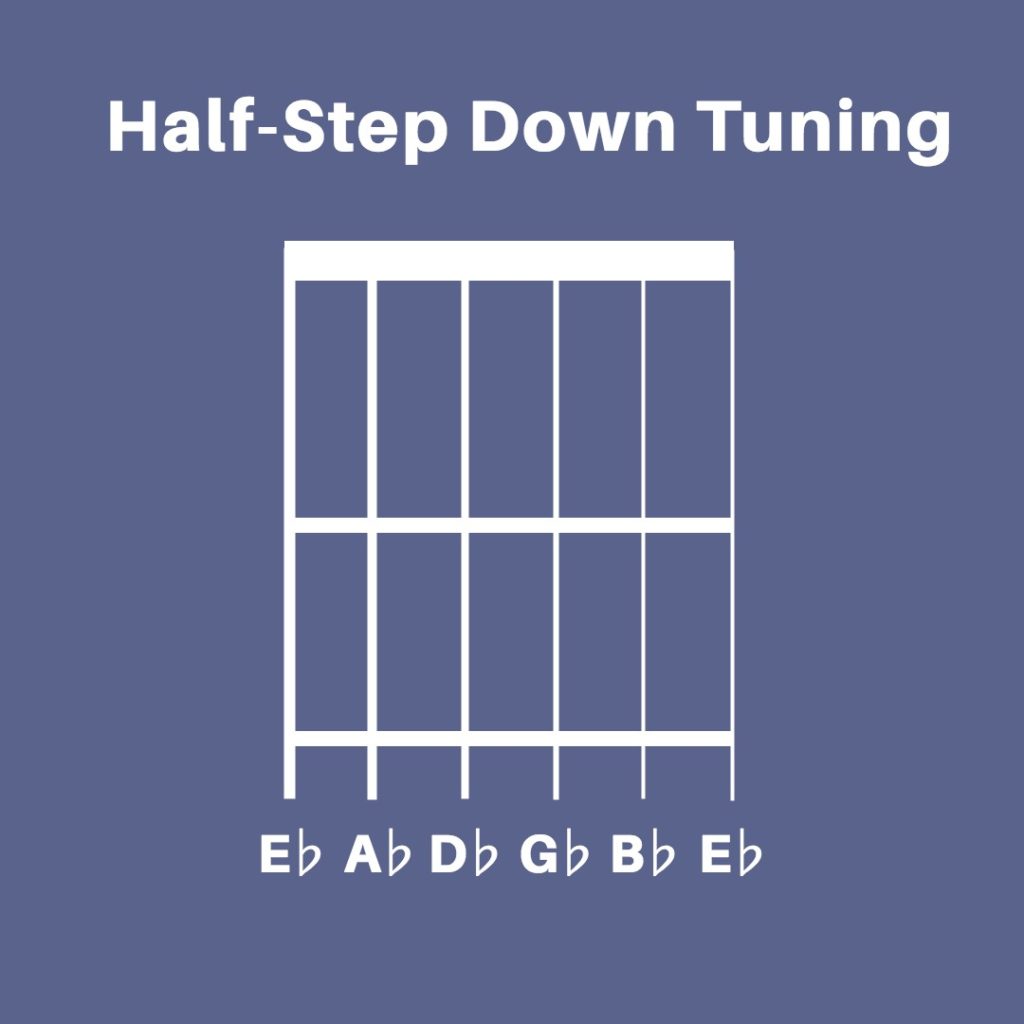
How to Tune a Guitar to Drop D
Drop D tuning differs from standard tuning in only one way: the sixth string is tuned down one tone, from E to D, resulting in DADGBE tuning.
To drop D tune a guitar, simply lower your sixth string by a whole tone by comparing it to the open fourth D string:

This is one of the simplest tunings, and is popular in blues, country, and folk.
How to Tune a Guitar to Open G
In this tuning, strumming your guitar without putting any fingers on the fretboard will result in a G chord. The pitch pattern will be DGDGBD.
Start by lowering your sixth and first strings from E to D by comparing them to the open fourth string. Then, lower your fifth string by a whole tone by comparing it to the third string. This may take a bit of practice because of the octave difference, but will soon become second nature!

In this tuning, you can play any major chord simply by barring your finger across different frets – no need for complicated chord shapes!
Open G tuning is popular in blues and rock, most notably because of Keith Richards, who wrote the riffs for many of the Rolling Stones’ most popular songs with this tuning. If you want to cover “Brown Sugar” or “Gimme Shelter”, do it in open G!
How to Tune a Guitar to Drop C
Drop C tuning, or CGCFAD, creates a heavier, lower sound on your guitar. This tuning is more advanced than the previous ones, as it requires you to change the pitch of every string. As always, start in standard tuning. Then:
- Fret the fifth (A) string at the third fret. This is your reference for what the sixth string should sound like, although the sixth string should be one octave lower.
- Fret the newly C-tuned sixth string at the seventh fret. This will produce a G, which you will use as a reference note to tune your fifth string.
- Fret the newly G-tuned fifth string at the fifth fret. This will produce a C, which you will use as a reference note to tune your fourth string.
- Fret the newly C-tuned fourth string at the fifth fret. This will produce an F, which you will use as a reference note to tune your third string.
- Fret the newly F-tuned third string at the fourth fret. This will produce an A, which you will use as a reference note to tune your second string.
- Fret the newly A-tuned second string at the fifth fret. This will produce a D, which you will use as a reference note to tune your second string.

Tuning By Ear While Training Your Ear
The first few times you tune a guitar by ear, it can be frustrating – sometimes you just can’t track down that strange-sounding string. It may be tempting to reach for that electronic tuner, but don’t give up! Your ear will steadily get better and better at recognizing those “off” notes, and tweaking them to the right pitch.
Best of all, your sensitivity to pitch will improve considerably, making you a better musician all-round, and helping you with your improvisation, singing, songwriting, and more.
The post How To Tune Your Guitar By Ear appeared first on Musical U.
�What is the role and importance of time signatures in mu…
https://www.musical-u.com/learn/how-to-hear-and-create-time-signatures/
�What is the role and importance of time signatures in music? If you’ve ever wondered how time signatures work, how to figure them out, and how to choose your own when writing songs, this article is for you. 😁 https://www.musical-u.com/learn/how-to-hear-and-create-time-signatures/
Improvisation is a wonderfully fun musical activity but i…
https://www.musical-u.com/learn/12-ways-to-be-a-better-improviser/
Improvisation is a wonderfully fun musical activity but it can be challenging to learn. 🎹 Here are 12 effective ways you can develop and improve your own ability to improvise music. 🎵😎 https://www.musical-u.com/learn/12-ways-to-be-a-better-improviser/